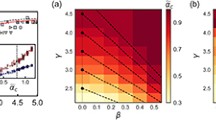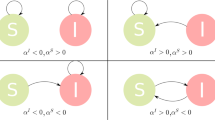Abstract
During the early outbreak of the COVID-19 pandemic, the mobility patterns of individuals in many regions in China exhibit notable changes: initially, there was a significant reduction in mobility, followed by a gradual recovery. Based on this observation, here we study epidemic models on a particular type of time-varying network where the links undergo a freeze-recovery process. We first focus on an isolated network and find that the recovery mechanism could lead to the resurgence of an epidemic, while the influence of link freezing on epidemic dynamics is intricate. In particular, we show that the final epidemic size is a non-monotonous function of the freezing rate. This result challenges our conventional idea that stricter prevention measures (corresponding to a larger freezing rate) could always have a better inhibitory effect on epidemic spreading. We further investigate an open system where a fraction of nodes in the network may contract the disease from the “environment” (the outside infected sources). In this case, a second wave can emerge even if the number of infected nodes has declined to zero, which cannot be explained by the isolated network model.










Similar content being viewed by others
Data availability
Data will be available on reasonable request.
Notes
References
Maier, B.F., Brockmann, D.: Effective containment explains subexponential growth in recent confirmed COVID-19 cases in China. Science 368(6492), 742–746 (2020)
Zhang, J., Litvinova, M., Liang, Y., et al.: Changes in contact patterns shape the dynamics of the COVID-19 outbreak in China. Science 368(6498), 1481–1486 (2020)
Zhang, J., Dong, L., Zhang, Y., et al.: Investigating time, strength, and duration of measures in controlling the spread of COVID-19 using a networked meta-population model. Nonlinear Dyn. 101(3), 1789–1800 (2020)
Kraemer, M.U.G., Yang, C.H., Gutierrez, B., et al.: The effect of human mobility and control measures on the COVID-19 epidemic in China. Science 368, 493–497 (2020)
Zhou, Y., Xu, R., Hu, D., et al.: Effects of human mobility restrictions on the spread of COVID-19 in Shenzhen, China: a modelling study using mobile phone data. Lancet Digital Health 2(8), e417–e424 (2020)
Schlosser, F., Maier, B.F., Jack, O., et al.: COVID-19 lockdown induces disease-mitigating structural changes in mobility networks. Proc. Natl. Acad. Sci. USA 117(52), 32883–32890 (2020)
Gibbs, H., Liu, Y., Pearson, C.A.B., et al.: Changing travel patterns in China during the early stages of the COVID-19 pandemic. Nat. Commun. 11(1), 1–9 (2020)
Badr, H.S., Du, H., Marshall, M., et al.: Association between mobility patterns and COVID-19 transmission in the USA: a mathematical modelling study. Lancet Infect. Dis. 20(11), 1247–1254 (2020)
Yang, L., Wei, C., Jiang, X., Ye, Q., Tatano, H.: Estimating the economic effects of the early Covid-19 emergency response in cities using intracity travel intensity data. Int. J. Disaster Risk Sci. 13(1), 125–138 (2022)
Zanette, D.H., Risau-Gusmán, S.: Infection spreading in a population with evolving contacts. J. Biol. Phys. 34(1), 135–148 (2008)
Meloni, S., Arenas, A., Moreno, Y.: Traffic-driven epidemic spreading in finite-size scale-free networks. Proc. Natl. Acad. Sci. USA 106(40), 16897–16902 (2009)
Ruan, Z., Tang, M., Liu, Z.: Epidemic spreading with information-driven vaccination. Phys. Rev. E 86(2), 036117 (2012)
Yang, H., Gu, C., Tang, M., et al.: Suppression of epidemic spreading in time-varying multiplex networks. App. Math. Model. 75, 806–818 (2019)
Gross, T., D’Lima, C.J.D., Blasius, B.: Epidemic dynamics on an adaptive network. Phys. Rev. Lett. 96(20), 208701 (2006)
Marceau, V., Noël, P.A., Hébert-Dufresne, L., Allard, A., Dubé, L.J.: Adaptive networks: coevolution of disease and topology. Phys. Rev. E 82(3), 036116 (2010)
Yang, H., Tang, M., Zhang, H.: Efficient community-based control strategies in adaptive networks. New J. Phys. 14(12), 123017 (2012)
Karsai, M., Kivelä, M., Pan, R.K., et al.: Small but slow world: How network topology and burstiness slow down spreading. Phys. Rev. E 83(2), 025102 (2011)
Perra, N., Gonçalves, B., Pastor-Satorras, R., Vespignani, A.: Activity driven modeling of time varying networks. Sci. Rep. 2, 469 (2012)
Holme, P., Saramäki, J.: Temporal networks. Phys. Rep. 519(3), 97–125 (2012)
Pozzana, I., Sun, K., Perra, N.: Epidemic spreading on activity-driven networks with attractiveness. Phys. Rev. E 96(4), 042310 (2017)
Zino, L., Rizzo, A., Porfiri, M.: Continuous-time discrete-distribution theory for activity-driven networks. Phys. Rev. Lett. 117(22), 228302 (2016)
Vazquez, A., Rácz, B., Lukács, A., Barabási, A.L.: Impact of non-noissonian activity patterns on spreading processes. Phys. Rev. Lett. 98(15), 158702 (2007)
Acemoglu, D., Chernozhukov, V., Werning, I., Whinston, M.D.: Optimal targeted lockdowns in a multigroup SIR model. Am. Econ. Rev. Insights 3(4), 487–502 (2021)
Farboodi, M., Jarosch, G., Shimer, R.: Internal and external effects of social distancing in a pandemic. J. Econ. Theory 196, 105293 (2021)
Ventura, P.C., Aleta, A., Rodrigues, F.A., Moreno, Y.: Modeling the effects of social distancing on the large-scale spreading of diseases. Epidemics 38, 100544 (2022)
Kurmi, S., Chouhan, U.: A multicompartment mathematical model to study the dynamic behaviour of COVID-19 using vaccination as control parameter. Nonlinear Dyn. 109(3), 2185–2201 (2022)
Meng, X., Lin, J., Fan, Y., et al.: Coupled disease-vaccination behavior dynamic analysis and its application in COVID-19 pandemic. Chaos Solitons Fract. 169, 113294 (2023)
Pastor-Satorras, R., Castellano, C., Mieghem, P.V., Vespignani, A.: Epidemic processes in complex networks. Rev. Mod. Phys. 87(3), 925 (2015)
Ruan, Z.: Epidemic spreading in complex networks. Sci. Sin-Phys. Mech. Astron. 50(1), 010507 (2020)
Aleta, A., Martín-Corral, D., Pastore y Piontti, A., et al.: Modelling the impact of testing, contact tracing and household quarantine on second waves of COVID-19. Nat. Hum. Behav. 4(9), 964–971 (2020)
Belik, V., Geisel, T., Brockmann, D.: Natural human mobility patterns and spatial spread of infectious diseases. Phys. Rev. X 1(1), 011001 (2011)
Ruan, Z., Wang, C., Hui, P.M., Liu, Z.: Integrated travel network model for studying epidemics: Interplay between journeys and epidemic. Sci. Rep. 5, 11401 (2015)
Wang, L., Wang, Z., Zhang, Y., Li, X.: How human location-specific contact patterns impact spatial transmission between populations? Sci. Rep. 3, 1468 (2013)
Ruan, Z., Tang, M., Gu, C., Xu, J.: Epidemic spreading between two coupled subpopulations with inner structures. Chaos 27(10), 103104 (2017)
Poletto, C., Tizzoni, M., Colizza, V.: Heterogeneous length of stay of hosts’ movements and spatial epidemic spread. Sci. Rep. 2, 476 (2012)
Zheng, M., Wang, C., Zhou, J., et al.: Non-periodic outbreaks of recurrent epidemics and its network modelling. Sci. Rep. 5, 16010 (2015)
Meidan, D., Schulmann, N., Cohen, R., et al.: Alternating quarantine for sustainable epidemic mitigation. Nat. Commun. 12(1), 220 (2021)
Zhang, X., Ruan, Z., Zheng, M., et al.: Epidemic spreading under mutually independent intra-and inter-host pathogen evolution. Nat. Commun. 13(1), 6218 (2022)
Perra, N., Balcan, D., Gonçalves, B., Vespignani, A.: Towards a characterization of behavior-disease models. PLoS ONE 6(8), e23084 (2011)
Zheng, M., Wang, W., Tang, M., et al.: Multiple peaks patterns of epidemic spreading in multi-layer networks. Chaos Solitons Fract. 107, 135–142 (2018)
Weitz, J.S., Park, S.W., Eksin, C., Dushoff, J.: Awareness-driven behavior changes can shift the shape of epidemics away from peaks and toward plateaus, shoulders, and oscillations. Proc. Natl. Acad. Sci. USA 117(51), 32764–32771 (2020)
Pastor-Satorras, R., Vespignani, A.: Epidemic spreading in scale-free networks. Phys. Rev. Lett. 86, 3200 (2001)
Moreno, Y., Gomez, J.B., Pacheco, A.F.: Epidemic incidence in correlated complex networks. Phys. Rev. E 68, 035103 (2003)
Liu, Z., Hu, B.: Epidemic spreading in community networks. Europhys. Lett. 72, 315 (2005)
Colizza, V., Pastor-Satorras, R., Vespignani, A.: Reaction-diffusion processes and metapopulation models in heterogeneous networks. Nat. Phys. 3, 276 (2007)
Wang, L., Li, X.: Spatial epidemiology of networked metapopulation: an overview. Chin. Sci. Bull. 59, 35113522 (2014)
Xuan, Q., Du, F., Yu, L., Chen, G.: Reaction-diffusion processes and metapopulation models on duplex networks. Phys. Rev. E 87, 032809 (2013)
Ruan, Z., Hui, P., Lin, H., Liu, Z.: Risks of an epidemic in a two layered railway-local area traveling network. Eur. Phys. J. B 86, 13 (2013)
Acknowledgements
This work was partially supported by the Zhejiang Provincial Natural Science Foundation of China under Grants Nos. LY21F030017 and LR19F030001, by the National Natural Science Foundation of China under Grant No. 61973273, and by the Key R &D Programs of Zhejiang under Grant No. 2022C01018.
Funding
The authors have not disclosed any funding.
Author information
Authors and Affiliations
Corresponding author
Ethics declarations
Conflict of interest
The authors have no relevant financial or non-financial interests to disclose. The authors declare no conflicts of interest.
Additional information
Publisher's Note
Springer Nature remains neutral with regard to jurisdictional claims in published maps and institutional affiliations.
Rights and permissions
Springer Nature or its licensor (e.g. a society or other partner) holds exclusive rights to this article under a publishing agreement with the author(s) or other rightsholder(s); author self-archiving of the accepted manuscript version of this article is solely governed by the terms of such publishing agreement and applicable law.
About this article
Cite this article
Shu, X., Ruan, Z. How the reversible change of contact networks affects the epidemic spreading. Nonlinear Dyn 112, 731–739 (2024). https://doi.org/10.1007/s11071-023-09078-2
Received:
Accepted:
Published:
Issue Date:
DOI: https://doi.org/10.1007/s11071-023-09078-2




